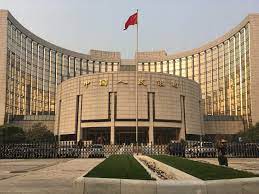
China's central bank unexpectedly reduced key policy rates for the second time in three months, providing more evidence that policymakers are stepping up their monetary easing initiatives to support the economy's faltering recovery.
Analysts claimed that the action created the possibility of a next week reduction in China's lending benchmark loan prime rate (LPR).
Market observers noted that in July, declining loan growth and rising deflation risks demanded additional monetary easing measures to stem the decline. Default worries at some house developers and a private wealth manager's late payments also had an impact on financial market confidence.
"All of these add to the urgency that policymakers need to act fast before consumer and business confidence deteriorate sharply," said Tommy Wu, senior China economist at Commerzbank.
The medium-term lending facility (MLF) rate for select financial institutions totaling 401 billion yuan ($55.25 billion) was cut by the People's Bank of China (PBOC) by 15 basis points, from 2.65% to 2.50%.
The PBOC stated in an online statement that the purpose of the cash infusion was to "keep banking system liquidity reasonably ample" by offsetting factors like tax payments.
Twenty respondents, or 77%, of the 26 market observers surveyed by Reuters this week said the central bank will maintain the MLF rate. Only six survey participants predicted a slight rate cut.
"The surprising rate cut was a prompt response to support subdued credit data and China recovery (that) may unleash yuan depreciation pressure towards 7.3," said Ken Cheung, chief Asian FX strategist at Mizuho Bank.
"In particularly, the PBOC may intend to support the medium-term credit conditions via the asymmetric cut, and opened the way for a cut to LPR, especially the 5-year LPR, to support the struggling property sector."
Markets frequently utilise the medium-term policy rate as a benchmark before making any adjustments to the lending benchmarks. The MLF rate acts as a guide for the LPR. The LPR's monthly fixing is due the following Monday.
The central bank said in an online statement that it also added 204 billion yuan through seven-day reverse repos while lowering borrowing prices by 10 basis points to 1.80% from 1.90% earlier.
China's central bank continues to stand out among those around the world because it has relaxed monetary policy to support a stalling recovery while others have been in cycles of tightening as they fight excessive inflation.
The yuan is under increasing pressure and is at danger of outflows due to the rate change on Tuesday, which increased the yield gap with other major economies, particularly the United States.
The Chinese yuan has underperformed other Asian currencies this year, losing around 5% against the US dollar. As of 01:45 GMT, the yuan was trading at 7.2842 to the dollar, down from the previous close of 7.2580.
The 10-year government bond yields in China decreased to 2.56%, the lowest level since May 2020.
To support the overall economy, the PBOC cut key policy rates in June, but since then, data have been progressively worse.
(Source:www.dailystar.net)
Analysts claimed that the action created the possibility of a next week reduction in China's lending benchmark loan prime rate (LPR).
Market observers noted that in July, declining loan growth and rising deflation risks demanded additional monetary easing measures to stem the decline. Default worries at some house developers and a private wealth manager's late payments also had an impact on financial market confidence.
"All of these add to the urgency that policymakers need to act fast before consumer and business confidence deteriorate sharply," said Tommy Wu, senior China economist at Commerzbank.
The medium-term lending facility (MLF) rate for select financial institutions totaling 401 billion yuan ($55.25 billion) was cut by the People's Bank of China (PBOC) by 15 basis points, from 2.65% to 2.50%.
The PBOC stated in an online statement that the purpose of the cash infusion was to "keep banking system liquidity reasonably ample" by offsetting factors like tax payments.
Twenty respondents, or 77%, of the 26 market observers surveyed by Reuters this week said the central bank will maintain the MLF rate. Only six survey participants predicted a slight rate cut.
"The surprising rate cut was a prompt response to support subdued credit data and China recovery (that) may unleash yuan depreciation pressure towards 7.3," said Ken Cheung, chief Asian FX strategist at Mizuho Bank.
"In particularly, the PBOC may intend to support the medium-term credit conditions via the asymmetric cut, and opened the way for a cut to LPR, especially the 5-year LPR, to support the struggling property sector."
Markets frequently utilise the medium-term policy rate as a benchmark before making any adjustments to the lending benchmarks. The MLF rate acts as a guide for the LPR. The LPR's monthly fixing is due the following Monday.
The central bank said in an online statement that it also added 204 billion yuan through seven-day reverse repos while lowering borrowing prices by 10 basis points to 1.80% from 1.90% earlier.
China's central bank continues to stand out among those around the world because it has relaxed monetary policy to support a stalling recovery while others have been in cycles of tightening as they fight excessive inflation.
The yuan is under increasing pressure and is at danger of outflows due to the rate change on Tuesday, which increased the yield gap with other major economies, particularly the United States.
The Chinese yuan has underperformed other Asian currencies this year, losing around 5% against the US dollar. As of 01:45 GMT, the yuan was trading at 7.2842 to the dollar, down from the previous close of 7.2580.
The 10-year government bond yields in China decreased to 2.56%, the lowest level since May 2020.
To support the overall economy, the PBOC cut key policy rates in June, but since then, data have been progressively worse.
(Source:www.dailystar.net)





